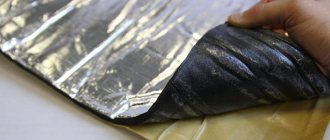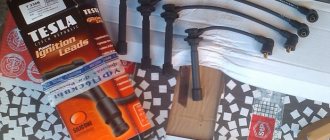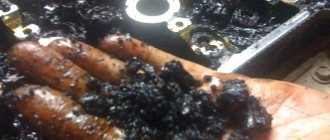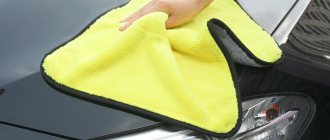Washing a car engine is included in the list of mandatory maintenance work. At the same time, there is still no consensus among car owners about whether the procedure is worth performing. There are some subtleties that not all car owners know about. That is why it is worth looking into this issue separately and deciding whether and how to properly wash the engine yourself.
Why do you need to wash the engine and engine compartment?
You need to wash your car's engine compartment once or twice a year. At the same time, answering the question of why to do this, it is worth giving the following arguments:
- a clean engine does not heat up, since dust acts as a body insulator and creates additional load on the car’s cooling system. If you wash it off, the motor will run smoothly, without interruption.
- If the engine compartment is clean, it is easier to maintain.
- In a dirty engine compartment, fires may arise from leaks of gasoline and automobile oil. For this, a simple spark or a breakthrough of exhaust gases is enough.
- Washing the engine is also necessary because it allows you to independently detect a leak on the clean surface of the power unit. As a result, it becomes possible to take timely measures without waiting for the situation to worsen.
- Before selling, the engine must also be washed in order to show the potential buyer that it works without interruption. In addition, a clean engine compartment allows him to adequately assess the technical condition of the engine.
Engine problems after washing
Sometimes after washing, various problems arise in the operation of the power plant, which are expressed as follows:
- the engine does not start or stalls;
- the engine is unstable (idle speed fluctuates, there are twitches);
- the oil pressure light comes on;
- "check" is on.
If, after washing the unit, all electrical connections are restored, the starter turns and the fuel pump runs, but the engine does not start, then attention should be paid to the following:
- on cars equipped with an ignition distributor, you need to get rid of water under the distributor cover by wiping or blowing. They also dry the high-voltage wires, turn out and inspect the spark plugs, and remove moisture from the spark plug wells;
- on machines in which the ignition coils are installed separately for each cylinder, you need to dismantle and dry each part separately. Otherwise, perform actions similar to the previous paragraph;
- when the engine stalls (one of the cylinders does not work), a drop in power is felt, and the operation of the unit is accompanied by strong vibration. In addition, twitching of the car itself is possible. The most common reasons for this behavior are possible due to problems with the ignition system discussed in the first paragraph. If drying does not help, the reasons may be due to a malfunction of one of the motor sensors;
- if the speed fluctuates, this indicates problems with the throttle valve or its position sensor. In this case, cleaning and drying of the elements is required, as well as disconnecting the battery terminals for 10–15 minutes;
- The oil pressure light on the dashboard may come on due to moisture getting on the oil sensor itself or its contacts;
- The “check” indication indicates a malfunction of the motor. The fault can be determined only after diagnosing the unit by reading errors from the computer at a service center.
If the check light comes on, this indicates a problem with the engine.
Sometimes problems that arise after washing the engine go away on their own as a result of the unit completely drying.
How to properly wash a car engine yourself
Washing a car engine with your own hands is not as simple a procedure as it seems. The fact is that a powerful jet of water can pierce the hood insulation; in addition, water in this case will penetrate into the spark plug wells, or under the rubber caps on the spark plugs. Also, a strong jet of liquid can rip off various covers and hanging elements located underneath.
If you do not have experience in washing the engine compartment, or you do not know how to wash a car engine with your own hands, you are better off going to a professional car wash. They have experience in performing the work and special equipment for this.
If you decide to remove existing contaminants in the engine compartment and properly wash the car engine yourself, you should adhere to the following algorithm of actions:
- First, you need to seal all the main components and assemblies of the motor so that water does not get into them. This is especially true for electrical wiring and the air filter. This can be done using plastic film and tape. It is necessary to cover all factory stickers placed on the engine.
- Then you need to clean the engine compartment from oil and dirt with a specially purchased chemical composition. To do this, a certain amount of these fluids is applied to the engine. In order for the chemicals to take effect, you need to wait the time specified in the instructions and then rinse off the detergents with a stream of water under pressure or steam under light pressure.
- When the washing procedure is completed, it is necessary to remove the protective film from the components and assemblies and thoroughly dry the engine compartment with compressed air. At home, this can be done using a regular hair dryer operating at less than full power. If you need such equipment, and you cannot quickly find a hair dryer, you can dry the motor with a vacuum cleaner.
- The work is completed by removing the resulting stains and drips using a microfiber sponge or suede cloth.
Which auto chemical products are suitable?
There are two types of liquids that can be used:
- Specialized. Such compositions are developed specifically for certain types of pollution. For example, if you need to remove oily deposits, then the appropriate product will do the job perfectly, but it will be useless against other contaminants. Specialized formulations are more suitable for heavy, old contaminants.
- Universal. Suitable for complex treatment, however, due to the fact that they are not directed against a specific type of pollution, sometimes it is necessary to carry out the washing again. Universal type preparations can be used if the engine is not very dirty.
Healthy! When processing it yourself, you can also use regular dishwashing detergent. It effectively removes fatty inclusions, does not contain too aggressive components (will not harm plastic and rubber components) and is inexpensive.
Detergent compositions are sold in different containers. However, if you buy a 5-liter canister, it will be very inconvenient to use (you will have to first pour some liquid into a smaller bottle). Therefore, the best option is considered to be compositions in the form of sprays, which allow you to apply the liquid evenly:
- STP 73500EN (spray). A 0.5 liter bottle is enough for several uses. The product (costs about 450 rubles) is suitable for a car, SUV or minibus. After applying the composition you need to wait 15 minutes. After this, the product will remove up to 85% of complex dirt and grease.
- Motorraum-Reiniger (spray from Liqui Moly). A container with a volume of 0.4 liters will cost 630 rubles. The drug is also applied for 15-20 minutes. During this time, it actively breaks down fatty deposits, road dust and oily stains. At the same time, as the manufacturer himself states, a 100 percent result can be achieved. However, this liquid is often counterfeited, so you need to make sure that the composition is really branded.
- LAVR. A domestic product costs about 900 rubles per 5 liters. This is a concentrate that is suitable for all types of contaminants and prevents the formation of corrosion. The composition cannot be applied in its pure form; it must first be diluted with water in a ratio of 1:3.
Healthy! Car shampoos, which are successfully used to wash the car body, are not recommended, as they often contain rather aggressive reagents.
In addition to the liquid, before processing the engine you will need foil, sponges, gloves, rags and brushes (only soft products can be used, so metal sponges should be abandoned).
How to wash a car engine
In order to find out which product will best perform the washing function, it is necessary to study in advance the technical characteristics of certain products. For example, relatively old cars have an engine compartment that is not too densely filled. As a result, you can work in it only using bottles with a hand sprayer. Their design allows for precise dosing of detergent. This makes it possible not to spend a large amount of product when washing the power unit, which is better than washing a car engine with a bucket. New cars with tight engine compartments are treated with aerosols that penetrate even hard-to-reach places.
In specialized auto accessory stores you can purchase concentrated detergents that can be used to remove the most stubborn stains. It is worth remembering that when washing the engine, it is strictly forbidden to use products that contain acids or other chemicals.
Separately, it is worth noting that the use of gasoline or diesel fuel when washing the engine is strictly prohibited in order to avoid a fire.
Tips and tricks
Almost every car wash has a warning that the staff is not responsible for the condition of your car after washing the engine. This is why you need to take care of your car yourself:
- ask the washer to cover important electronic components in your engine compartment (for example, distributor cover, fuse box, ECU, switch). To do this, you can use cling film, plastic bags and tape;
- Using a high-pressure washer, you need to wash the engine from a distance. In no case should you bring the nozzle close, as the enormous pressure can damage electrical connections and break the tightness of sealing products;
- Every self-respecting car wash should have the ability to supply compressed air. Therefore, you should definitely blow out the engine compartment, which will significantly reduce the likelihood of unpleasant consequences. Particular attention should be paid to all electrical connectors and sensors;
- After washing, especially in winter, it is advisable to let the car run for 15-20 minutes to ensure that it gets rid of moisture.
These recommendations, of course, must be followed if you want to properly wash the engine with your own hands.
Advantages of steam cleaning
The most popular way to clean the engine compartment is to wash the car engine with steam. This method of washing has a number of advantages over other means of keeping the engine compartment clean:
- there is no need to use chemical cleaning agents, which is safe for the paintwork of the engine compartment;
- the ability to clean all elements of the car at once, and not just the power unit;
- production simultaneously with washing of disinfection of the interior and engine compartment, as steam has a high temperature, at which almost all harmful microorganisms die;
- cleaning with steam is a dry car engine wash, since a car treated in this way can go on a trip immediately after all the necessary procedures have been carried out;
- steam perfectly washes away oil and fuel stains, which adds shine to chrome parts;
- steam is able to penetrate into the seams and joints of machine parts, as well as into the folds of the upholstery;
- Steam cleaning takes 30-40 minutes, which is several times faster than traditional cleaning.
avtoexperts.ru
Surely many motorists saw it on the list when arriving at a car wash. Indeed, since a car has an engine, which, like other components and assemblies, is susceptible to contamination, it needs to be cleaned. Is this really so, how often does the engine need to be “washed”, and how to do it correctly - we’ll talk about all this today.
In fact, car manufacturers do not necessarily recommend cleaning the power unit from dirt. This is especially true for foreign automakers. The operating instructions for foreign cars talk about periodically washing the body (and in winter, the underbody of the car), but there is no mention at all about cleaning the engine. The absence of this point can be explained by the fact that cars sold on the European market are much less susceptible to pollution than Russian ones, simply due to the fact that the roads in Europe are cleaner, and, therefore, car engines are kept cleaner.
Engine washing
For us, even a short period of operation is enough so that it is impossible to look into the engine compartment without gloves. Let's return to our domestic realities. Let’s say you looked under the hood of a car and discovered that the engine is so dirty that you can’t even see the nameplate under the layer of dirt. Is washing necessary in this case? Our answer is yes.
The fact is that layers of dirt deposited on the engine during driving can cause many troubles. One of them is engine overheating, especially in the summer. This is most relevant for Soviet-made cars, the cooling system of which often cannot cope with the increased load and is not able to withstand high external temperatures and internal heating, which, in particular, is provoked by those very layers of dirt. Another problem that can befall a car with a dirty engine is the ignition of the power unit. A fire in the engine compartment can break out when a sparking spark plug can ignite oil residues, which also accumulate along with dirt on the surface of the unit.
You can wash the car engine yourself, or you can entrust this procedure to a car wash. Although the latter is often protested by people who, after poor-quality “rinsing” of the engine at car washes, had problems - a short circuit or engine failure. During your next visit to the car wash, take a closer look at the price list: it will probably be written in small letters that the administration of the enterprise is not responsible for the technical problems of the car after “water procedures”.
Engine washing in service
And the human factor and lack of professionalism in this matter cannot be ignored either: this procedure is rare, and therefore there may simply not be a specialist in engine cleaning at the car wash. You can’t entrust such a responsible operation to a person who may simply not know what means to clean the engine with, what parts of the unit need to be carefully isolated from water, and, importantly, how to dry it properly. Therefore, it would be best to wash the engine yourself, especially since there is nothing extremely complicated in this procedure.
Before you begin directly washing the engine, you need to stock up on all the necessary materials and tools. You will need: car wash products (there are universal ones, but it is better to use specialized ones, since their chemical composition is designed to dissolve deposits that accumulate specifically on the engine), plastic film, a brush, a brush for hard-to-reach places, rags, dry towels and a compressor, if which will need to be used to dry the unit.
Special engine cleaner
And, of course, the required amount of water, which may vary depending on the degree of contamination, the design of the motor and its size. If you have all this, then open the hood and proceed to the preparatory stage.
Never wash a hot engine! It is best to carry out this operation on a warm engine (30 degrees) - this will contribute to a better reaction of the special cleaning agent. First of all, we cover all wiring, battery, alarm (if installed) and other devices with plastic wrap. After all the areas most vulnerable to water are covered, apply a special cleaning agent to the contaminated surface and leave it for the period specified in the instructions for use. The chemicals in this product take time to dissolve the dirt. After a certain period of time, we begin cleaning hard-to-reach areas with a brush and brush. When these procedures are completed, wash off the dirt with warm water. It is important to remember that high-pressure apparatus should never be used to wash the engine. Then we wash off the remaining traces of dirt using rags and brushes, and rinse again with enough water. We wash the battery parts with a soda solution (soda ash and water in a 1:1 ratio) - this will protect it from corrosion. We blot the wet motor with dry towels, blow it with a compressor and leave it to dry in the sun. Engine cleaning is complete!
Before starting a cleanly washed engine, make sure that there is no dirt, moisture or residue of plastic film left on its parts, in short, all those components that can lead to a short circuit or ignition. It is also important to unscrew the spark plugs, wipe them dry and remove moisture from the spark plug wells. After thoroughly drying the unit, you can start it and check its operation.
Just a photo of a clean engine - after washing
Cleaning products
To properly clean the engine compartment, you need to know how to wash a car engine. You need to purchase special products, and you should not use other types of cleaners, as they can damage the paintwork of certain elements of the vehicle’s engine compartment. Separately, it is worth mentioning that washing equipment used in the washing process (for example, Karcher) should only be used together with the car shampoo that is specified in the instructions for it.
Self-washing technology
The easiest way is to entrust this work to car wash specialists. Those who did this on their own are unlikely to consider their prices for this work inflated. Especially considering the cost of the drugs used. But someone will rightly think that no one can do any job better than the owner.
What can you wash with?
Of all the means invented by motorists, it is best to focus on the use of special cleaning sprays to clean the engine. All other methods are inconvenient, unreliable, or accessible only to specialists with the appropriate equipment.
Drying the engine
After finishing the procedure, the washed engine compartment and the engine itself must be dried with a dry paper towel or rag. Moreover, if after this it is discovered that there are traces of corrosion on the elements of the engine and engine compartment, their locations must be cleaned using baking soda and water in a 1:1 ratio. The washed and treated engine should be started and run to check its performance.
Why is dirt under the hood dangerous?
The danger of severe contamination of the engine and its surroundings does exist, but it is slightly exaggerated.
However, there are negative factors.
- Most often, poor heat dissipation through a thick layer of dirt is mentioned, although the engine is still cooled through the radiator, and not through the outer surface of the cylinder block, head or valve cover. But some parts, such as the fuel rail, actually need to release excess heat without the participation of antifreeze.
- Under layers of road dust mixed with oil, you may not be able to see the problem. The logical question here is how often the owner will look at something there, especially if it is a modern, complex and reliable engine in a tightly packed engine compartment. But specialists will still clean their work area before work, and they will do it professionally.
- The issue of selling a used car also has two sides. A clean engine indicates the owner’s diligence in caring for the car, which gives additional points in competition with competitors. But many people know the tricks of resellers, with the help of which they thus mask the half-dead engine leaking along all the gaskets. On a dry and dusty engine, the history of the car is better visible; here it is worth emphasizing that it is slightly dusty, and not overgrown with a substance reminiscent of asphalt.
- Fire safety can also be judged from different points of view. A clean engine does not contain petroleum products that can ignite. But on the one hand, there is something to burn there even without oil flows, and on the other hand, a fire can be started precisely in the process of illiterate washing.
In any case, carry out a wet general cleaning under the hood at least occasionally, but it is necessary. This cavity of the car is poorly protected from dirt, and the more it accumulates there, the more difficult it is to wash it later. Sometimes it is simply impossible to avoid damage.
conclusions
The car engine needs to be washed, just like all its other structural elements. At the same time, when washing it, it is necessary to follow certain rules in order not to damage the power unit and the components of the engine compartment. The frequency of washing the engine is once a month and should be adhered to so that the engine not only looks neat, but is also in good working order. With a clean engine, you can see traces of fuel and oil leaks in advance, and eliminate the faults that caused them in a timely manner.
Hydrogen washing
One of the most progressive ways to clean the internal surface of the engine from contaminants is washing with a hydrogen station. A special device that generates hydrogen is connected directly to the car battery. After startup, the system begins to supply a combustible mixture entering through the air intake pipe to remove carbon deposits. Under the influence of burning hydrogen, carbon particles in the engine are separated from the walls and fly out through the exhaust system of the car.
Thus, the pistons, gas distribution mechanism, turbines and USR valves, as well as exhaust system elements, including particulate filters and catalyst, are cleaned. It is believed that the result of hydrogen washing is especially visible in cars with a diesel engine rather than a gasoline one. The cleaning process itself takes approximately 50 minutes, during which time about 100 liters of hydrogen passes through the motor. Of course, you won’t be able to clean the internal combustion engine and related systems on your own; you need competent specialists and professional equipment.
Undoubtedly, a clean engine and engine compartment ensure safe and durable operation of the car. Taking into account the mode of use and age of the car, experts recommend carrying out preventive cleaning of the internal combustion engine system at least once a year.
If you decide to wash your car engine for the first time or your car has problems after washing, consult the specialists of the FAVORIT MOTORS technical centers.
Experienced craftsmen, who constantly improve their skills with car manufacturers, will suggest the most suitable washing method or carry out all the necessary repair work with a guarantee. We use only modern equipment and original materials. You will be satisfied with the cost of services and the level of our customer service. Sign up for service Service center contacts Ask a question
Mistake 3. Incorrect washing technique
Rinsing off the detergent with high pressure water at very close range is the third mistake. To effectively remove oil and oxides mixed with dust and sand, the engine and units are watered generously. As a result, even high-quality sealing materials often fail, and moisture penetrates into electrical connectors, where electrochemical corrosion occurs during operation. In the future, this leads to deterioration and loss of contact. This is especially harmful for older cars whose seals have lost their elasticity over the years.
Error 1. Washing a hot engine
First of all, many people don’t bother and start washing the engine, which has been heated up to 90 degrees or more in operating mode. Sudden temperature changes provoke the appearance of small cracks in sealed joints, where moisture penetrates, and only physical deformation of hot parts is quite possible. The manifold, EGR valve, plastic valve cover, ignition coil housing and other parts may simply crack. Before washing the engine compartment, be sure to let the engine cool to 50-60 degrees.
Preparing the engine for washing
Before starting the engine washing procedure, it is necessary to carry out preparatory work. This is done to protect the components from unwanted moisture.
What should be done:
- remove parts that restrict access to the engine;
- disconnect the negative terminal of the battery;
- remove the engine compartment protection;
- treat nearby parts with a water-repellent aerosol;
- cover sensors, connectors and wires with polyethylene film.
This concludes the preparation for engine washing. After the work is completed, you can begin washing.











